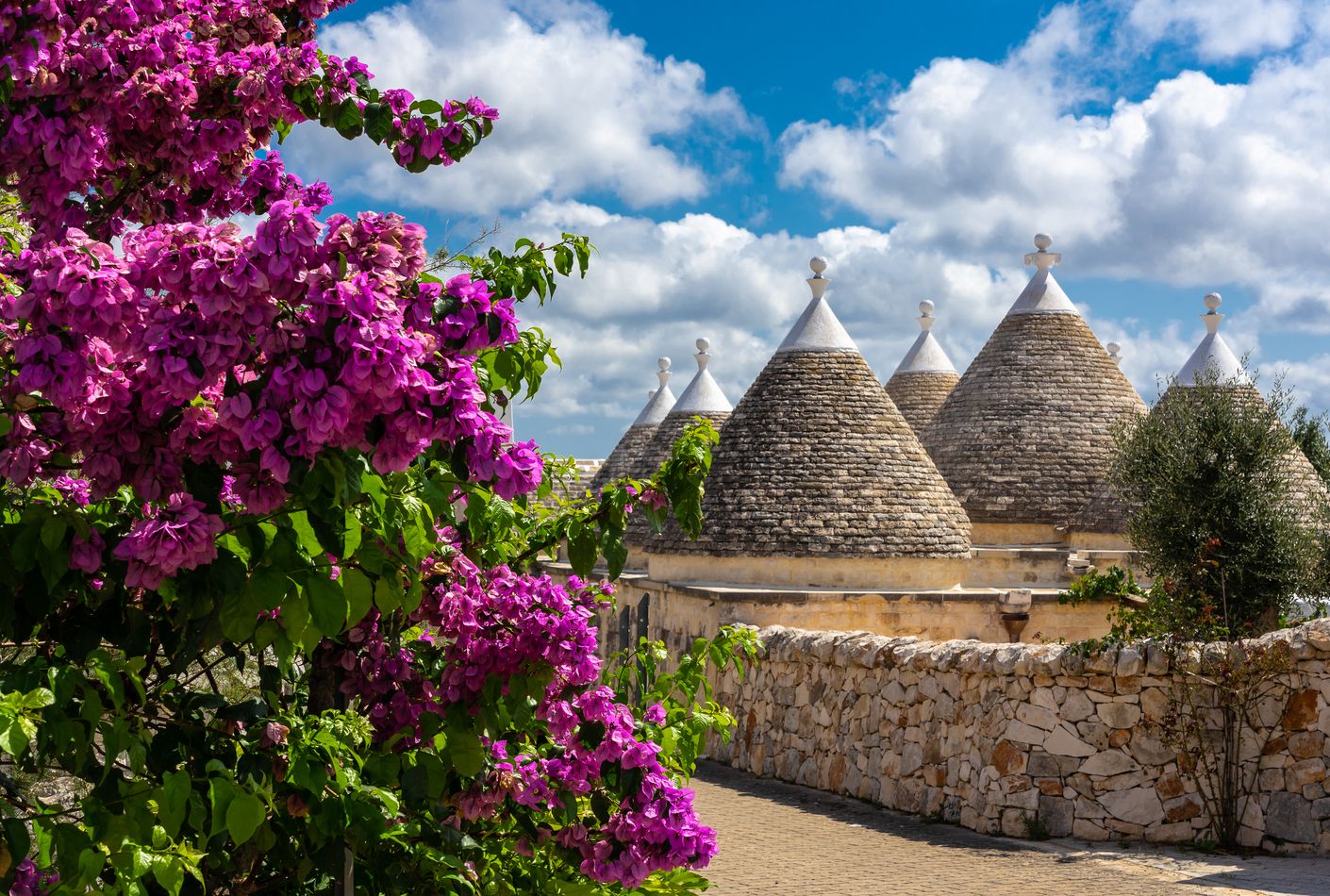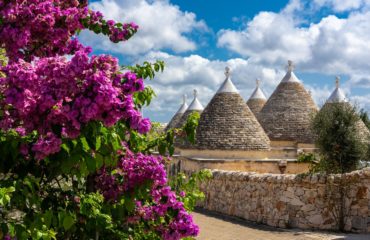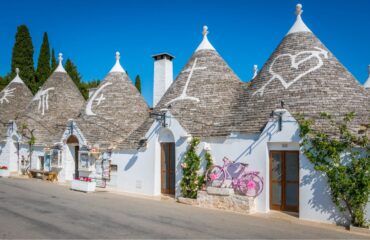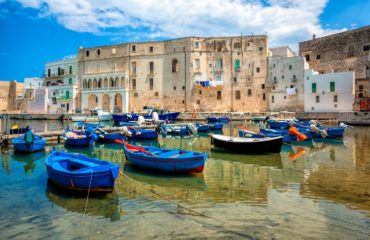PUGLIA, WHAT ELSE?
Day trip to Monopoli, Alberobello, Locorotondo & Polignano a Mare
- Explore the picturesque fishing town of Monopoli and trace evidence of its heyday as Apulia’s most prosperous trade centre
- Discover how a 15th century tax fraud eventually led to the creation of a World Heritage Site as you admire Alberobello’s iconic trulli
- Take in splendid views of the Adriatic Sea from Polignano a Mare, the inspiration for the timeless Italian hit song Volare
-
Category
-
Hobbies & Interests
-
DurationFull day
-
Destination
PUGLIA, WHAT ELSE?
Day trip to Monopoli, Alberobello, Locorotondo & Polignano a Mare
Discover four of Apulia’s best-loved towns on this full-day trip to the Itria Valley and the Adriatic coast.
In the morning your private guide and chauffeur will pick you up at your accommodation and drive you to Monopoli. The origins of the town’s name are still something of a mystery, though the ancient Greek words Monos Polis suggest it must have been highly regarded as a truly “Unique City” ever since its early beginnings. Monopoli’s history, architecture and urban layout were profoundly influenced and shaped by the town’s strategic east-facing position along the Adriatic coast. Its sea-front walls and 16th century castle harbour many a gripping story. For centuries pirate incursions, sieges and invasions shook what is today a sleepy, peaceful fishing village but was once a lively trading hub and Apulia’s busiest port town.
Traces of Monopoli’s heyday still survive within the town’s historic centre, crossed by ribbons of medieval alleys and punctuated with splendid Baroque buildings. As you weave your way through narrow stone streets, you will certainly come across the 18th century Cathedral of the Madonna della Madia, Monopoli’s most famous attraction which safeguards the memory of a prodigious event. Construction began in 1107 but came to a halt after running out of roof beams. According to legend, ten years later, in 1117, a raft carrying a Byzantine icon of the Virgin Mary miraculously drifted into the port and the boards from the raft were used to finish the roof. Though very little is left of the original Romanesque structure, since the cathedral was entirely rebuilt in 1772, the much venerated image of the Madonna, as well as what are believed to be the wooden beams from the raft, are still carefully preserved within the church, giving visitors a view of the serendipitous event that permitted its completion.
Further highlights of your stroll through Monopoli are Piazza Vittorio Emanuele, one of the largest squares to be found anywhere in Apulia, and the column of shame, incorporated within the clock tower in Piazza Garibaldi. Here, as a punishment, those found guilty of crimes were once tied and exposed to public mockery. Views of the old port where fishing boats bob gently in the emerald waters against the backdrop of Palazzo Martinelli’s Venetian-style loggia are among the lasting impressions you will take away with you.
After the visit rejoin your driver and reach the picture-postcard town of Alberobello, world-famous for its iconic trulli houses. Here you will discover how an ingeniously devised tax fraud curiously led to the creation of a UNESCO World Heritage Site. Trulli are whitewashed dwellings consisting of thick dry-stone walls assembled without mortar and topped by conical stone roofs. Bizarre as it may seem, these houses were originally designed in the late 15th century with the aim of fooling royal authorities and avoiding taxation, a successful trick that worked right up till 1797 when Alberobello acquired its status as a proper town. Indeed, until then, the local feudal lords, the shrewd Counts of Acquaviva, obliged their subjects to live inside trulli which could be quickly and easily dismantled. Taxation applied only to populated settlements and Alberobello could be transformed in no time into a vast expanse of rubble if the royal officers decided to inspect. Today these structures are still inhabited and constitute “an outstanding example of human settlement that retains its original form to a remarkable extent” as stated by the UNESCO committee. They also live on as a reminder of characteristic Italian artfulness. Enjoy a leisurely stroll along the town’s winding alleys lined with shops selling hand-painted ceramic artefacts, gastronomic specialities and all sorts of trulli-shaped souvenirs, before setting off for your next destination.
Perched on a hill in a panoramic position at the heart of the Itria Valley, pretty Locorotondo offers sweeping views of the surrounding landscape from its belvedere: a mosaic of vineyards enclosed by dry stone walls, silvery olive groves enveloping old farms, hundreds of trulli peppering the green fields. Founded in 1000 AD, the town derives its name from the Latin words locus rotundus literally meaning “round place”, owing to the circular plan of its historic centre. Narrow concentric streets flanked by traditional cummerse houses with unusual pitched roofs are a typical feature of this quaint little town. Follow your guide on a walk through Locorotondo, pausing to admire its graceful palazzi and churches. Every year since 2008 the citizens have participated in a competition called Balconi Fioriti, which encourages residents of Locorotondo to adorn their balconies and front doors with flowering pots, thus adding to the town’s homely allure. Locorotondo is best-known as the region’s wine-producing capital so be sure to drop in at a local enoteca and request a glass of the local DOC designated white wine.
The last stop on your tour will bring you to the lovely coastal town of Polignano a Mare. Its famous bay, set between sheer cliffs, adorns many a postcard, but the town’s historic centre is just as enchanting, with its maze of cheerful streets and squares lined with whitewashed houses and blooming balconies. Here, you may browse a range of irresistible shops, admire breathtaking seascape views from the town’s panoramic terraces and pause to read a series of inspirational lines and poetry quotations painted on the walls of the buildings by Guido, a contemporary poet and local resident. Don’t forget to pay homage to Domenico Modugno, the famous Italian composer who sang and wrote the international hit “Volare”, born here and immortalized in a bronze statue facing the waves with arms outspread, eternally embracing the ocean.
In the afternoon your private chauffeur will drive you back to your accommodation.
- A Mercedes vehicle and professional driver at your disposal for a full-day excursion to Monopoli, Alberobello, Locorotondo and Polignano a Mare
- A full-day private tour with an expert licensed guide
- Tips
- Meals
- The order of the sites visited may change






